Link: Vestax – Price: $899/€799/£599
Table of Contents
Preface
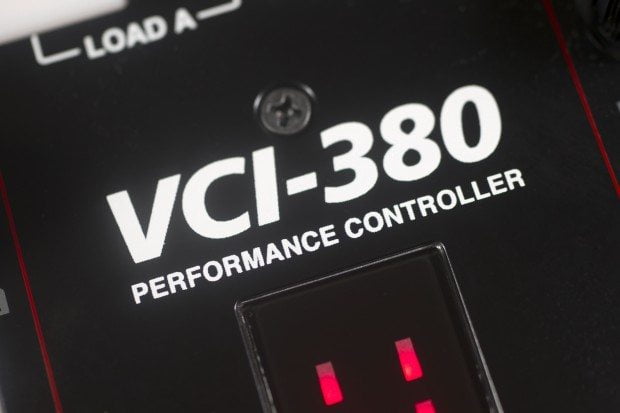
Continuing the DJWORX tradition of more detail and multiple opinions, this is the first of two full reviews. There are a number of VCI-380s floating around the wider DJWORX circles, and so far the reaction has been overwhelmingly positive. Read on for my full opinion.
Vestax VCI-380 Introduction

While they may not have been the first, Vestax certainly defined the current standards for DJ controller layouts. The VCI-100 can be classed as a standard in a time where technology moves too quickly to have such things. The VCI-300 followed it and became ridiculously popular for Serato ITCH users. Then the 4 channel revolution swept through scene, which seemed to catch Vestax by surprise, leaving them with no offering for the 4 channel hungry hordes.
But Vestax aren’t fools. Last year saw the VCI-400 appear, a product that wasn’t designed for any particular software package, and aimed to please as many people as possible. But again, this was for the 4 channel guys, or at least those MIDI guys wanting the most versatile unit that would fulfil their needs and expectations.
For me, the 400 was not the controller I’ve been waiting for. I want 2 decks, hot cues, loops and analogue mixer ability in a compact unit. Some have come close – the Numark NS6 had almost everything, but was too big. And then Musikmesse saw the VCI-380 blip on the radar. And right away I was hooked. Could this be my ideal controller?
In a Nutshell
The Vestax VCI-380 is a Serato ITCH based DJ controller in the now classic mould. It’s 2 channels, 3 band EQ, static jog wheels, effects etc – you know, the usual. But this has the added benefits of high quality performance pads for samples, hot cues, auto loops, slicing and loop rolling. Add to this the ability to use it as a regular mixer, and you have a very comprehensive 2 channel controller.
First Impressions

It’s certainly familiar. Take the DNA of a VCI-300, transplant a couple of PAD-Ones, a VFX-1, and graft in some Novation Twitch genetic material and you have a VCI-380. It’s as if all the cool bits of digital DJing have been dragged together, polished a bit and made into a very cool controller.
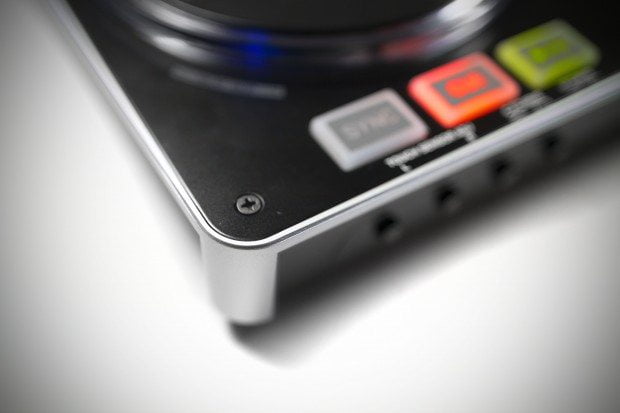
Build is classic Vestax – tank-like with tell-tale signs of hard learned experience. Each time they bring forth a new design, you can see the clear improvements over the old ones. Not just in terms of quality, but also in workflow. I suppose we should class this as a VCI-300 update, so let’s look at the differences in build between them. Physically it’s slightly heavier, and a little bigger, but still bag-sized and flight safe. The chassis has become a little more stylish than utility – gone is the fingerprint unfriendly scratch magnet of a faceplate, and in comes an easily removable and very Styleflip friendly one. This is surrounded by a Silver plastic trim, designed solely to protect the edges and corners, which is wrapped around a formed metal base. It’s not quite the formerly heavyweight metalfest of the VCI-100, but it does feel substantial enough to take a knock or two.
The controls are of the now expected high quality. The smaller buttons are a hard plastic, with the rest being spongy rubber and just about every one of them has an LED backlight, which in all but the brightest lighting conditions are nice and colourful. The metal stemmed pots are rock solid and nutted to the body, and every other control is of an equally high quality. Lessons have been learned from the VCI-300, and sorted out properly on the 380.
Layout-wise, the VCI-380 is symmetrical. Once upon a time, this was a real issue, mainly for those used to a conventional setup. But these days, it’s quite the norm and for me works very well indeed. It also adopts a more formalised 2-decks-and-a-mixer layout that people will be used to, and does work better. In a new twist for controllers, and probably borrowed from Pioneer, the business end of the VCI-300 i.e. the pads are set in a sightly inclined section all of their own. Not only does this make the pads work better, but it helps to reinforce the layout somewhat. Really good work here Vestax.
As a current controller, it’s hard to fault the quality, the looks and the layout. I kind of prefer the older clunkier rounded stylings, but that’s personal taste than anything. But so far, so good.
Jog Wheels

This is an area where Vestax dance to the beat of their own drum. Most manufacturers adopt a CDJ derivative bevel edged wheel designed to resemble a traditional platter. But when Vestax brought forth their VCI-100, it was clear that they had different ideas. This particular wheel is the evolution of various designs, and while very definitely being a jog wheel, there are some key features that put these into a different category.
Firstly, they’re a little bigger than before – 135mm across, giving you a slightly larger tactile area for your fingers. At this size, every little counts. Secondly, the tension adjust, like the VCI-400 is now in the middle of the wheel. The old method of applying pressure at the edge of the wheel was good but not perfect. This new adjuster method applies tension evenly to the centre and feels a lot smoother. The method of adjustment is good too – I favour pressing down on the adjuster to keep it still and moving the jog wheel. The wheel adjusts from near free running to having to spin hard to get a full revolution, so every style is catered for. And rather than a recessed screw control at the back, the touch sensitivity is now a proper knob on the front on the VCI-380.

By far the biggest change is the addition of LEDs on the jog wheel itself. These are pretty common on media players, but less so on controllers. I’ve never been a fan myself, as the accuracy isn’t always great. But I’m very happy to see these on here. One of the biggest issues with laptop DJing is waveform syndrome, where DJs find themselves glued to the screen instead of working their gear. And this LED ring goes a very long way to stopping this.
The ring is bright but does have a lag when scratched. But the LED position exactly matches the on-screen one – even down to the jumping back to 12 o clock of the cue points as per ITCH, and returns to the right position almost instantly. After watching waveforms for years, pulling the jogwheel back to the right place without waveform syndrome was a joy. Very big thumbs up on this one Vestax. Perhaps in the distant future, those wheels will be circular LED screens with label art. One can wish.
Faders
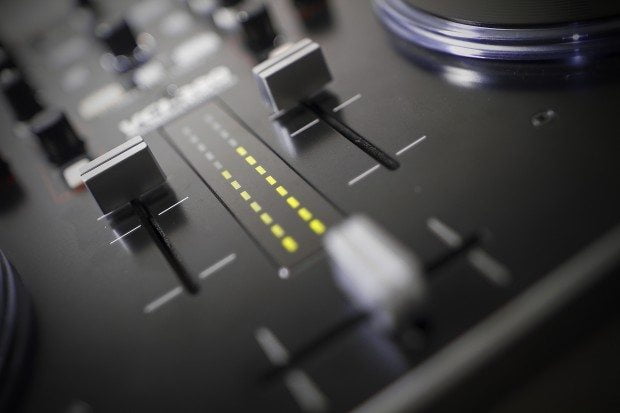
Vestax have a very long history with robust faders. When controllers first came out, faders were merely good enough. But now, with demands on hardware and software being ever higher, fader requirements are becoming important factors, especially on a performance unit like this.
For a controller, the fader section is pretty well specced. The faders are 45mm, with regular square Vestax caps and raised 3mm above the faceplate. The crossfader is slick and wobble-free, whereas the linefaders are a tad stiffer and better suited to mixers. Both have physical curve controls (down to roughly 2mm lag), and the crossfader has a software reverse/disable toggle.
While the crossfader is perfectly scratchable and able to pull off the clickiest of crabs, Vestax have made it relatively easy to swap out the stock fader for their rather nice CF-X2 crossfader. I don’t have one to check it out with, but it feels amazing in my 05 Pro IV mixer. I can also confirm that a regular Innofader is too deep to fit, but the Innobender version does work. So if the stock fader isn’t good enough for you (for most it will be), there are options.
Pitch
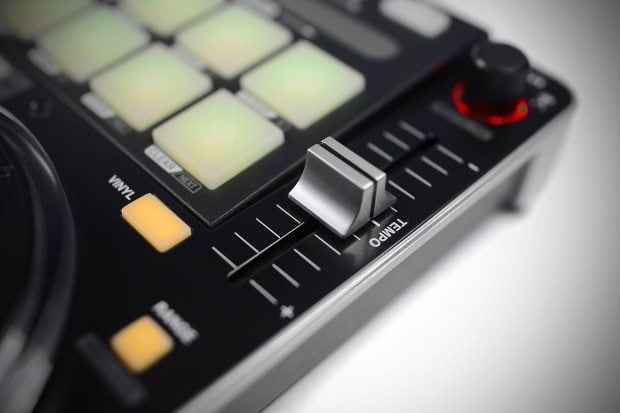
ITCH offers 8, 16 and 50% pitch ranges via a small button just above the jog wheel. Shift-hitting the button enables keylock – great speeded up, but not too clever when slowing down more than 15%. Given Serato’s pedigree in this area, I was a little disappointed. I was equally disappointed with the lack of pitch bend buttons, but that’s personal preference and can be achieved with the jog wheels.
The VCI-380 offers short 60mm throw pitch faders that are stable and smooth, but lack a centre detent or even any hardware LED indicator for 0%. Bearing in mind that these are short throw, the resolution is hard to nail, but seems to be 0.03% at 8%. Given the more sample/sync based workflow of the VCI-380, I’m less bothered than I would be on more mix-centric units, but it’s worth bearing in mind. And like previous ITCH units, I found it reasonably easy to confuse ITCH with repeated range changes and pitch shifts.
Treat pitch tenderly, and she will serve you well. But for me this is probably the weakest part of the VCI-380 by some way.
IDEA: Probably heading into broken record territory here, but Serato – I’ll just leave this one here…
Ins and Outs

The days of audio interface free controllers are almost gone. It’s pretty much expected that controllers will be plug and play – USB cable in, audio output in and you’re off. And when you get to this high-end level, ins and outs are quite seriously catered for.

Starting round the back, for the mobile guys who are adopting controllers on an increasing basis, there are 2 separate mic inputs – 1/4″ and XLR, and each with their own volume controls. Thankfully Vestax have thought to add chunky rubberised knobs to the volume controls, making reaching over the back less of a pain. Side note – no effects routing for the mics.
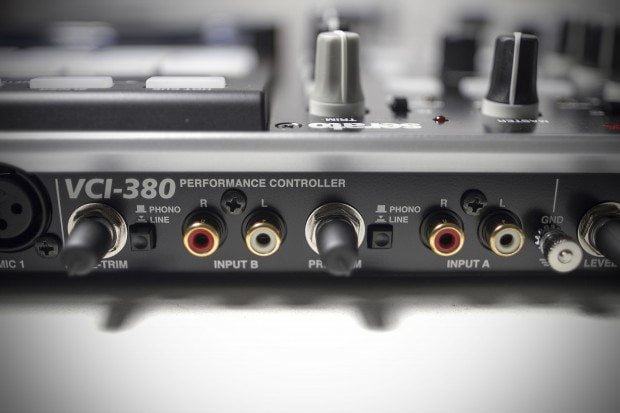
Next up are the RCA inputs. They’re switchable between line and phono and also have their own trim controls. These inputs are useful should you need to reboot your laptop or swap over between DJs as they work without the USB connected, and still use the onboard EQ and even th effects controls work as filters. Clever stuff. More importantly, these allow you to use your favourite DVS package through the VCI-380, but we’ll get to that in a few paragraphs.
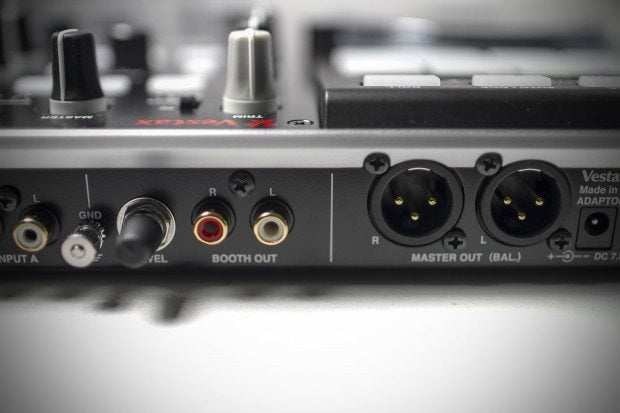
Outputs are served pretty well with balanced XLR outputs – just XLRs, rather than having unbalanced RCAs, as well as separate booth outputs with its own volume control on the back. There’s also the now standard large and small headphone jacks with master/cue and volume controls. No split cue though. Am I the only one who likes having a split cue?
One important point with the VCI-380 is that it requires power, which in turn means it’s loud, and all the LEDs light up nice and bright.
